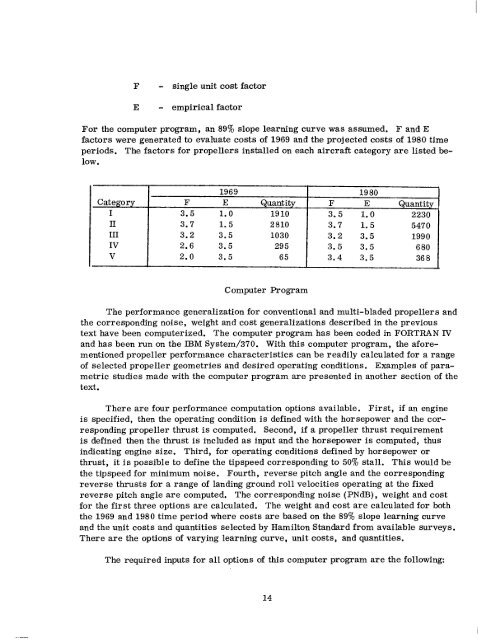COMPUTER PROGRAM USER'S MANUAL FOR ... - CAFE Foundation
COMPUTER PROGRAM USER'S MANUAL FOR ... - CAFE Foundation
COMPUTER PROGRAM USER'S MANUAL FOR ... - CAFE Foundation
You also want an ePaper? Increase the reach of your titles
YUMPU automatically turns print PDFs into web optimized ePapers that Google loves.
F - single unit cost factor<br />
E - empirical factor<br />
For the computer program, an 89% slope learning curve was assumed. F and E<br />
factors were generated to evaluate costs of 1969 and the projected costs of 1980 time<br />
periods. The factors for propellers installed on each aircraft category are listed be-<br />
low.<br />
196 9 19 80<br />
Category<br />
I<br />
F<br />
3.5<br />
E<br />
1.0<br />
Quantity<br />
19<br />
F<br />
10 3.5<br />
E Quantity<br />
1.0 2230<br />
I1<br />
3.7 1.5 2810 3.7 1.5 5470<br />
I11<br />
3.2 3.5 1030 3.2 3.5 1990<br />
IV<br />
2.6 3.5 29 5 3.5 3.5 6 80<br />
V<br />
2.0 3.5 3.4 65 3.5 36 8<br />
Computer Program<br />
The performance generalization for conventional and multi-bladed propellers and<br />
the corresponding noise, weight and cost generalizations described in the previous<br />
text have been computerized. The computer program has been coded in <strong>FOR</strong>TRAN Tv<br />
and has been run on the IBM System/370. With this computer program, the aforementioned<br />
propeller performance characteristics can be readily calculated for a range<br />
of selected propeller geometries and desired operating conditions. Examples of parametric<br />
studies made with the computer program are presented in another section of the<br />
text.<br />
There are four performance computation options available. First, if an engine<br />
is specified, then the operating condition is defined with the horsepower and the cor-<br />
responding propeller thrust is computed. Second, if a propeller thrust requirement<br />
is defined then the thrust is included as input and the horsepower is computed, thus<br />
indicating engine size. Third, for operating conditions defined by horsepower or<br />
thrust, it is possible to define the tipspeed corresponding to 50% stall. This would be<br />
the tipspeed for minimum noise. Fourth, reverse pitch angle and the corresponding<br />
reverse thrusts for a range of landing ground roll velocities operating at the fixed<br />
reverse pitch angle are computed. The corresponding noise (PNdB), weight and cost<br />
for the first three options are calculated. The weight and cost are calculated for both<br />
the 1969 and 1980 time period where costs are based on the 89% slope learning curve<br />
and the unit costs and quantities selected by Hamilton Standard from available surveys.<br />
There are the options of varying learning curve, unit costs, and quantities.<br />
The required inputs for all options of this computer program are the following:<br />
14

















